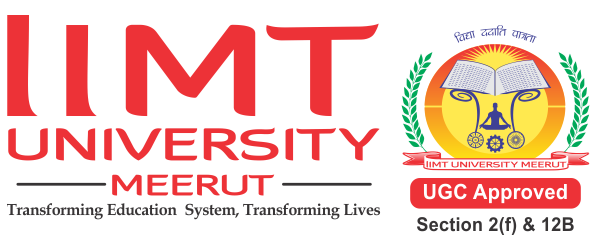Introduction:
Fungal skin infections are one of most prevalent dermatological issues nowadays. According to research, 40 million people have fungal infections. Fungal infections that appear superficially on skin, hair, nails are frequent & typically challenging to treat. Dermatophytes are one of most prevalent causes of tinea, which includes capitis, manuum, pedis, cruris, corporis, barbae & onychomycosis. Pityriasis versicolor & candidal infections are two additional common superficial cutaneous fungal infections. To treat these fungal infections, a variety of synthetic anti-fungal medications are utilised in clinical settings. These medications can be roughly categorised into four classes: azoles, allylamines, echinocandins, polyenes.
Despite this, there have been problems and obstacles along the way to modern treatment, most notably drug resistance. It is recognised that there is azole resistance. Different plant species’ photochemistry has shown that phytochemicals might be a more effective source of medication than synthetically created pharmaceuticals.
To combat illnesses brought on by aggressive & increasingly common used chemicals, Reduce the use of chemicals as anti-microbial agents due to endogenous micro-organisms that are resistant to synthetic anti-microbials. Essential oils & hydro-alcoholic extracts are examples of chemicals produced from plants. can definitely be crucial in this area.
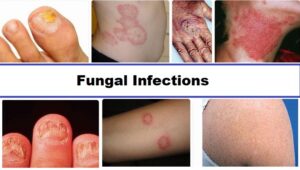
Fig.1: Fungal Infection of Skin
It has been proven effective to treat illness by administering medications to human body by a variety of ways, including oral, sub-lingual, rectal, parental, cutaneous, inward breath, so on. Skin conveyance, which aims to keep medication’s pharmacological or other effects to skin’s outer layer & inside the skin, is application of a medication containing specific information to skin in order to treat cutaneous problems like skin breakouts or the cutaneous symptoms of an underlying illness like psoriasis. Despite use of froths, splash, drugged powders, arrangements, & surprisingly cured glue frameworks, semi-strong plans in all of their variety overwhelm framework for effective conveyance.
Skin definitions, which explain how a medicine is administered to a specific location, are undoubtedly among most challenging design aspects. A practical effective detailed must offer a stable synthetic environment in a suitable distribution holder in order to accommodate various combinations that may have diverse, if not opposing, physiochemical qualities. Applying an effective definition to skin should take into account how skin’s climate may impact how quickly structures arrive to accomplish adequate skin absorption. Medication applied directly to skin offers an effective & focused treatment for related dermatological conditions. Since it eliminates oral organisation’s first-pass effects, GI dis-comfort, metabolic degradation, this route of medication delivery has grown in prominence. Only supplied fraction reaches blood stream as a result of primary prior effect.
The gel definitions, which were advised as an application, can be used to avoid these negative perspectives. Effective gel formulations serve as excellent delivery equipment for tablets since they are less oily and easy to remove from skin. All things considered, stage equipment that uses gels and prevents inorganic waste disintegrated anyway essentially scattered all throughout constant segment and large natural flotsam & In persistent stage, jetsam is broken down and haphazardly curled in adaptive chains. They are designed to be applied to skin & certain mucous films for their protective, preventative, or beneficial properties.
Skin fungus infection is one of most prevalent dermatological issues today. The therapy options available to doctors are many, ranging from solid to semi-solid dosage form to liquid dose formulation. Clear transparent gels have gained widespread acceptance among topical formulations in both cosmetics & pharmaceutical industries.
Clinicians & patients can choose from a number of vehicles, including solid, semi-solid, & liquid formulations, for topical treatment of dermatological diseases & skin care. The use of translucent gels has grown within the main category of semi-solid preparations of Drug delivery to patients utilising a range of pharmaceutical dosage forms, such as tablets, capsules, pills, suppositories, cream, gel, ointments, liquids, aerosols, injections, has been main method used to treat acute disease & a chronic sickness. Local dermatological problems can be effectively treated with focused medication delivery. Because it eliminates oral administration’s first-pass effects, GI discomfort, metabolic degradation, this method of drug delivery has grown in favour. Only 25–45% of oral dose that is delivered reaches blood circulation as a result of 1st pass effect. The gel formulations have been suggested as a topical treatment to get around these drawbacks. “Semi-solid system in which a liquid phase is constrained within a polymeric matrix in which a high degree of physical & chemical cross-linking introduced” is how gels are described.
❖ Signs of a Fungal Infection:
Rash is a common symptom of majority of minor mycoses. A lump & skin abnormalities can indicate infections under the skin & under skin. Deeper, less frequent fungal infections can exhibit meningitis & symptoms similar to pneumonia. Following can be a trigger as fungal cause:-
➢ Irritation.
➢ Scaly skin.
➢ Redness.
➢ Itching.
➢ Swelling.
➢ Blisters
❖ Causes:
Mycoses are caused by some fungi, including yeasts, moulds, some that can both be yeasts & moulds. Spores are omnipresent, & infection can happen through inhalation, skin-to-skin contact & through a cut, incision, & injection. Candida albicans is the most common fungus that affects individuals, especially when it appears as oral & vaginal thrush & commonly follows the use of antibiotics.
❖ Risk Elements
Immune systems that are compromised make people more prone to fungal infections. This includes people who are suffering from illnesses like HIV/AIDS & those who are receiving steroids & cancer treatments. Patients with diabetes are more susceptible to develop fungal infections. Extremely vulnerable groups include the young & aged. Anti-biotic-treated patients are more likely to get fungus infections. Invasive fungal infections can affect children whose immune systems are compromised, such as those who have cancer.
❖ Types of Fungal Infections:
Fungus can lead to skin infections on your body. Among the most common are athlete’s foot, jock itch, ringworm, yeast infections.
◇ Athlete’s Foot & Nail Fungus:
Tinea pedis, another name for athlete’s foot, is a fungal infection of foot. In warm, damp environments like shoes, socks, swimming, locker rooms, public restrooms, fungi thrive. They frequently inhabit hot, humid areas & summer. People who utilise public pools & bathhouses, tight-fitting footwear, sweaty socks are more likely to experience it.
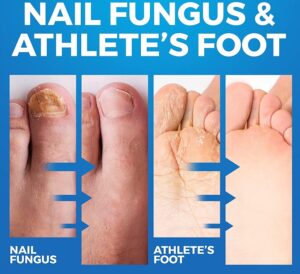
Fig.2: Athlete foot Infection
◇ Causes:
The fungus that cause athlete’s foot thrive on dead skin cells on your toenails, hair, upper layers of your skin. The infection can be brought on by at least four different fungi. Trichophyton rubrum is most widespread.
◇ Jock Itch:
Jockey itch is caused by a form of fungus called tinea. Tinea cruris is another name for the infection. The inner thighs, buttocks, and genitalia are among Tinea’s favourite warm, moist regions. Infections tend to occur more frequently in summer & in hot, humid settings. Jock itch is typically ring-shaped, red and itchy.
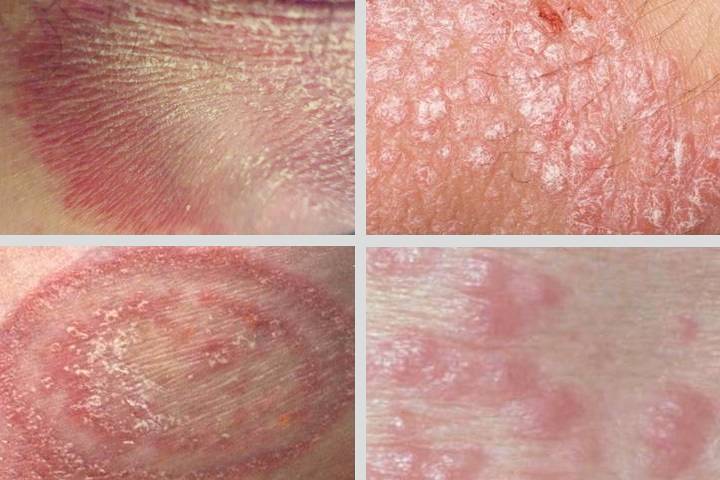
Fig.3: Jock Itch
◇ Nail Fungus:
If your nails are brittle, discoloured, or thick, you may have nail fungus. Toenails & fingernails may be affected. Maintaining clean, dry hands & feet, wearing dry socks & changing them frequently, wearing shoes in public showers & pool locker rooms, refraining from scratching affected skin, such as athlete’s foot, are all ways to prevent nail fungus. Don’t share nail clippers, wear wide-toed shoes to prevent crowded toes, wear comfortable clothing.
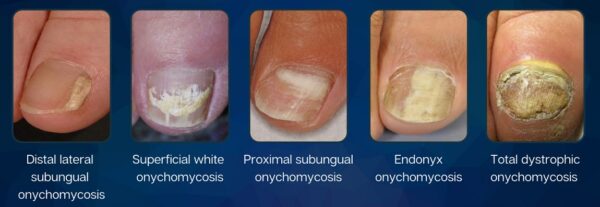
Fig.4: Nail Fungus
❖ Conclusion:
Ailments and disorders affecting the body & mind have always plagued man. However, diligent study by researchers around the globe has made it possible to treat, prevent, & eradicate many of these human diseases. Over time, the study of pharmaceutical science has grown gradually & is now essential to maintaining our health & preventing disease. The use of biomolecules including medicines, proteins, & other molecules to treat disease has advanced significantly during past few decades. Due to the constraints of drug transport via hazardous conditions in body, they initially could only be provided in limited circumstances.
How would you learn all about this and tackle it all? Now, this is where IIMT University, Meerut comes in. Because IIMTU is the best place in Meerut to learn all about the fungal infections, how to identify them, how to treat them with 100% result and how to provide knowledge to others. When you become a student of IIMTU you gain all the valuable knowledge for your life as well for other’s life. Come and take admission in IIMT University known as the best private university in U.P.
